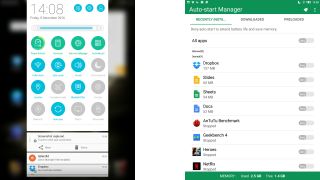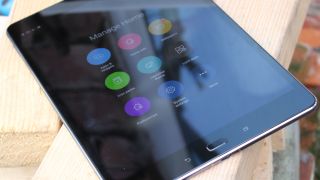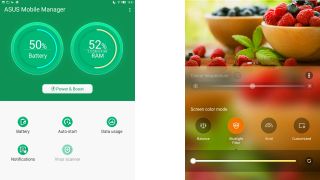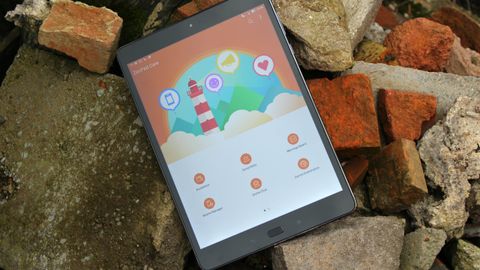Why you can trust TechRadar
Interface and software
- Hugely customizable interface
- Lots of bloat that can’t be uninstalled
With Android phones, there's a trend for using near-stock versions of the operating system, but given that it's largely unsuited to tablets, it's unsurprising that most slate manufacturers choose to customize Google's software with their own UI – and Asus is no exception.
While Android 6.0 Marshmallow was the original base software, the company has now provided an update to Android 7 that you can download over-the-air. There's no word on Android 8 Oreo or Android 9 Pie though and having gone this long without an update we suspect the ZenPad won't get them.
The software may be based on Android 6 or 7 (depending on whether you've updated) but it's overlaid with Asus' ZenUI. But this is actually one of the better custom skins we've seen in the tablet sector, and the company has put some thought into how it can enhance Android with unique options and the ability to tinker with how it looks and feels.
Nowhere is this more apparent than on the main home screen of the ZenPad 3S 10. Holding your finger down brings up a menu from which you have a dizzying degree of control over how the interface works.

You can change the scrolling animation, alter the app grid layout, install a custom icon pack to change the way apps work, add iOS-style "unread" notification badges to apps that support them and much more besides.
Granted, some of these features can be added to any Android device by installing a custom launcher from the Google Play Store, but it's nice to have them out of the box.

While it's not a new feature as such, the ability to wake the ZenPad 3S 10 from sleep by simply double-tapping the screen is welcome, as are the gesture-based shortcuts which fire up an application even when the display is off. For example, drawing a "W" will open the weather application, while a "C" boots the camera.
These gestures are quite common on smartphones intended for the Chinese market, and it's nice to see them being replicated on products with a more global reach.
Asus has included a few of its own applications with the ZenPad 3S 10, none of which we felt particularly inclined to use since they mostly replicate functionality and features already present in other apps, such as Google offerings or social networks like Instagram and Twitter.

ZenCircle is a prime example of this needless duplication; it's essentially Instagram for Asus users and allows photo sharing, but there are entire sections of the app devoted to pushing other Asus products, which makes the whole thing feel a bit like shameless marketing.
Asus Mobile Manager is slightly more useful, as it allows you to control your tablet's battery levels, data usage and RAM. Asus also includes its own gallery app and movie player, even though the ZenPad 3S 10 ships with Google's far more popular alternatives as standard.

Sadly, Asus doesn't allow you to uninstall its core applications – you can only disable them – so they take up valuable storage space despite the fact you're unlikely to use half of them.
Because of this, you only have access to 24.06GB of the device's 32GB storage total, but the ability to add more storage via microSD mitigates this problem slightly.
Movies, music and gaming
- Stereo speakers and a strong screen make this great for movies
- Hi-Res audio improves your music through headphones
- Speakers are annoyingly easy to obstruct
Thanks to the large size of their screens, tablets are the natural choice when it comes to consuming media on the move, and the ZenPad 3S 10 truly excels in this area. That gorgeous 9.7-inch 1536 x 2048 screen is the perfect viewing platform for film buffs, with the convincing contrast and gloriously vivid colors bringing movies to life.
From watching YouTube to streaming HD footage via Netflix, this tablet never fails to impress.
The only cause for complaint is the fact that widescreen movies run with borders at the top and bottom due to the screen's 4:3 aspect ratio – but that's a very minor grumble, and something that iPad owners have been perfectly happy living with since 2010.

Movie playback is accentuated by the excellent stereo speakers, which are capable of delivering good bass notes as well as effectively conveying higher frequencies.
The positioning of these speakers isn’t ideal though, as because they're both on the edge it's easy to cover them with your hand accidentally. Front-facing speakers would have been much better.

The ZenPad 3S 10 supports Hi-Res audio if you own compatible headphones and have properly encoded music, and the effect is remarkable. We tested the tablet with a pair of dodocool Hi-Res in-ear headphones and could certainly tell the difference between these tracks and those encoded at a lower quality.
As a gaming device, the ZenPad 3S 10 is equally successful. Titles like Real Racing 3 and Star Wars: Galaxy of Heroes ran smoothly and without any obvious framerate problems, and it goes without saying that the screen really enriches the visual impact.

Asus has included its own Game Manager application, which automatically pops up whenever you're playing a game; with it, you can flush out the RAM to improve performance or connect to your YouTube or Twitch account to live-stream gameplay.
The app can be disabled if you find it too intrusive (an icon remains on-screen whenever you're playing) but the streaming function is actually quite useful, and we came away impressed with how thoughtfully Asus has integrated such a feature.
Specs and benchmark performance
- Hexa-core chip and 4GB of RAM deliver smooth performance
- Solid benchmark results
The ZenPad 3S 10 has a hexa-core MediaTek MT8176 chipset beating at its heart, which uses two 2.1GHz ARM Cortex A72 cores and four 1.7GHz ARM Cortex A53 cores. A PowerVR GX6250 GPU – capable of hitting speeds of 700MHz – handles the graphical side of things, while 4GB of RAM is included to keep things ticking along as smoothly as possible.
All of this means that in general day-to-day use, the ZenPad 3S 10 is was as silky-smooth as Android tablet got at launch and still holds up now. Moving around the UI is a painless experience with no lag or delay, even when moving between apps. The device boots quickly too, and at no point did we ever find ourselves wishing for extra processing muscle.

While MediaTek's chipsets don't have the reputation of Qualcomm's, the MT8176 is more than capable of providing a fast user experience.
In the Geekbench 4 benchmark, the ZenPad 3S 10 scored 1558 in the single-core test and 3709 in the multi-core test. In the AnTuTu benchmark, it achieved a score of 76089. In 3DMark's Ice Storm Unlimited graphics test, Asus' tablet managed a 14550 rating, putting it slightly ahead of the Samsung Galaxy Tab S2.
Of course, it's beaten by the Samsung Galaxy Tab S4 and most of Apple's iPad range, but those devices are also newer and more expensive.
Current page: What's it like to use?
Prev Page Introduction, design and display Next Page Battery life and camera
Are we about to see Snapdragon X Plus revealed? Qualcomm teaser suggests Apple could have more to worry about than Elite CPU

Billions of user accounts have been breached since 2004 — here's what to do if you think you're one of them

Leaked Samsung Galaxy Z Flip 6 benchmark teases its key specs and performance
